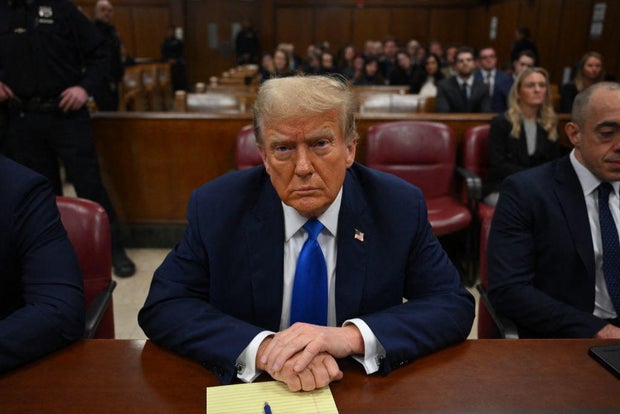Opening statements are underway in former President Donald Trump’s criminal trial in New York, as prosecutors and the defense begin laying out their case for jurors in the historic proceedings.
Trump is accused of falsifying business records to cover up a “hush money” payment during his 2016 campaign. Defense attorneys are expected to argue Trump has been charged on flimsy evidence from an untrustworthy key witness.
Arriving at the courthouse, Trump claimed the trial was “election interference” and part of an effort to keep him off the campaign trail. He called the case a “witch hunt” and “a shame.”
Prosecutors from Manhattan District Attorney Alvin Bragg’s office had 40 minutes to present their opening statements, and Trump’s attorneys have 25 minutes. The proceedings are not being televised, since New York law doesn’t allow recording of criminal proceedings. CBS News has reporters in the courtroom and in a nearby overflow room watching the trial.
Prosecutors’ opening statement
Matthew Colangelo, a member of Bragg’s team, kicked things off for the prosecution, laying out the central allegations in the case. Trump is charged with 34 felony counts of falsifying business records and has pleaded not guilty.
Just days before the 2016 election, Trump’s attorney at the time, Michael Cohen, paid $130,000 to adult film star Stormy Daniels to buy her silence about an alleged sexual encounter she said she had with Trump years earlier. Trump denies the encounter.
Colangelo said Cohen made the payment “at the defendant’s direction, and did it to influence the election.” He portrayed the payment as part of a scheme concocted by Trump, Cohen and David Pecker, the CEO of the parent company of the National Enquirer, to bury negative stories about Trump and attack his rivals. The plan was hatched at a meeting at Trump Tower in 2015, Colangelo said.
“Together they conspired to influence the 2016 presidential election,” Colangelo told the jury, saying Pecker agreed to act as Trump’s “eyes and ears” during the 2016 campaign. Pecker is expected to be the first witness called by the prosecution after opening statements.
Colangelo laid out the “catch and kill” tactic allegedly used by Pecker and Dylan Howard, the Enquirer’s editor, to shield Trump from negative stories. The practice involved buying the rights to someone’s story and then declining to publish the account, effectively keeping it hidden. They also used the Enquirer to publish unflattering stories about Trump’s rivals.
Prosecutors allege AMI, Inc., the Enquirer’s parent company, employed the “catch and kill” tactic twice before the payment to Daniels. One instance involved a $150,000 payment to a former Playboy model to secure the rights to her story. The model, Karen McDougal, also alleged an affair with Trump, which he denies. Colangelo told jurors they would hear a recording of Cohen promising to set up a shell company to buy the rights to McDougal’s story from the Enquirer to reimburse Pecker for the purchase.
In the weeks leading up to the 2016 election, Daniels’ lawyer approached the Enquirer about selling the rights to her story as well, Colangelo said. Howard put the lawyer in touch with Cohen, who negotiated the $130,000 payment, according to prosecutors. Colangelo said Trump hoped to delay the deal until after the election, and then not pay at all. Cohen ultimately transferred the money to Daniels’ attorney just days before Election Day.
“This was a planned, coordinated, long-running conspiracy to influence the 2016 election to help Donald Trump get elected,” Colangelo told the jury. “It was election fraud, pure and simple.”
Trump reimbursed Cohen for the payment in 12 monthly installments during the first year of his presidency, portraying them as checks for ongoing legal services in an illegal scheme to conceal their true purpose, according to prosecutors. Cohen ultimately received $420,000 — more than double the $130,000 payment to Daniels.
“Donald Trump was a very frugal businessman. He believed in pinching pennies. He believed in watching every dollar. He believed in negotiating every bill. He ran the Trump Organization with total control. You’ll hear testimony about his relentless focus on the bottom line. With Cohen and the ‘catch and kill’ deal, he didn’t negotiate the price down, he doubled it,” Colangelo said. “And you’ll hear evidence that the Trump Organization was not in the practice of paying twice what they owed for anything.”

